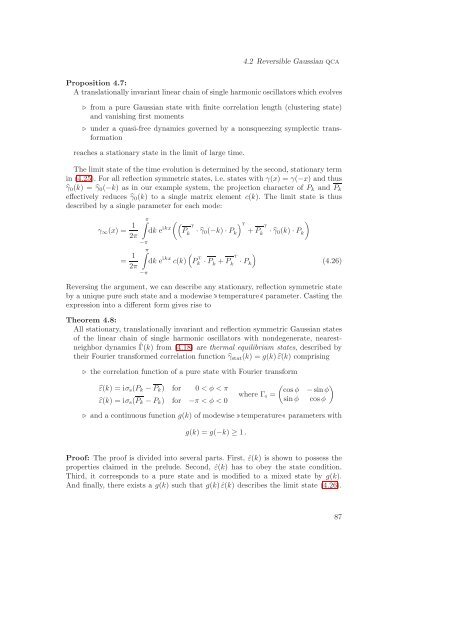Quantum Information Theory with Gaussian Systems
Quantum Information Theory with Gaussian Systems
Quantum Information Theory with Gaussian Systems
Create successful ePaper yourself
Turn your PDF publications into a flip-book with our unique Google optimized e-Paper software.
4.2 Reversible <strong>Gaussian</strong> qca<br />
Proposition 4.7:<br />
A translationally invariant linear chain of single harmonic oscillators which evolves<br />
⊲ from a pure <strong>Gaussian</strong> state <strong>with</strong> finite correlation length (clustering state)<br />
and vanishing first moments<br />
⊲ under a quasi-free dynamics governed by a nonsqueezing symplectic transformation<br />
reaches a stationary state in the limit of large time.<br />
The limit state of the time evolution is determined by the second, stationary term<br />
in (4.25). For all reflection symmetric states, i.e. states <strong>with</strong> γ(x) = γ(−x) and thus<br />
γ0(k) = γ0(−k) as in our example system, the projection character of Pk and Pk<br />
effectively reduces γ0(k) to a single matrix element c(k). The limit state is thus<br />
described by a single parameter for each mode:<br />
γ∞(x) = 1<br />
2π<br />
= 1<br />
2π<br />
π<br />
dk e ikx<br />
<br />
T<br />
T<br />
T<br />
Pk · γ0(−k) · Pk + Pk · γ0(k) · Pk −π<br />
π<br />
<br />
dk e ikx <br />
c(k) P T<br />
T<br />
k · Pk + Pk · Pk −π<br />
(4.26)<br />
Reversing the argument, we can describe any stationary, reflection symmetric state<br />
by a unique pure such state and a modewisetemperatureparameter. Casting the<br />
expression into a different form gives rise to<br />
Theorem 4.8:<br />
All stationary, translationally invariant and reflection symmetric <strong>Gaussian</strong> states<br />
of the linear chain of single harmonic oscillators <strong>with</strong> nondegenerate, nearestneighbor<br />
dynamics ˆ Γ(k) from (4.18) are thermal equilibrium states, described by<br />
their Fourier transformed correlation function γstat(k) = g(k) ε(k) comprising<br />
⊲ the correlation function of a pure state <strong>with</strong> Fourier transform<br />
ε(k) = iσs(Pk − Pk) for 0 < φ < π<br />
ε(k) = iσs(Pk − Pk) for −π < φ < 0 where Γ 0 =<br />
<br />
cosφ<br />
<br />
− sinφ<br />
sin φ cosφ<br />
⊲ and a continuous function g(k) of modewisetemperatureparameters <strong>with</strong><br />
g(k) = g(−k) ≥ 1 .<br />
Proof: The proof is divided into several parts. First, ˆε(k) is shown to possess the<br />
properties claimed in the prelude. Second, ˆε(k) has to obey the state condition.<br />
Third, it corresponds to a pure state and is modified to a mixed state by g(k).<br />
And finally, there exists a g(k) such that g(k) ˆε(k) describes the limit state (4.26).<br />
87
















